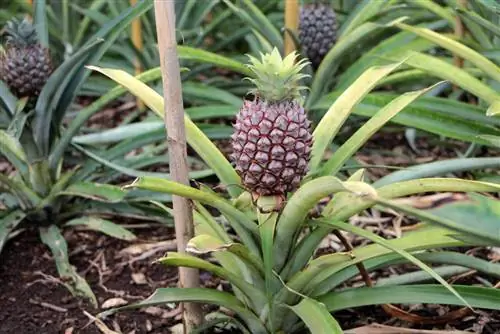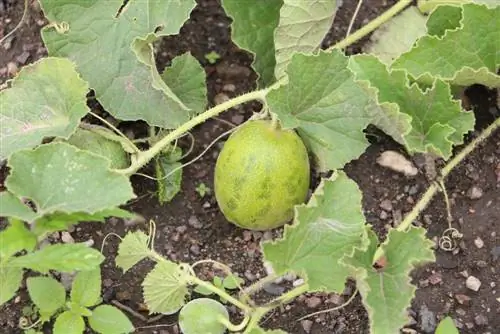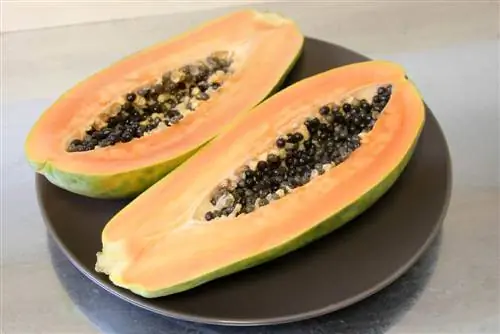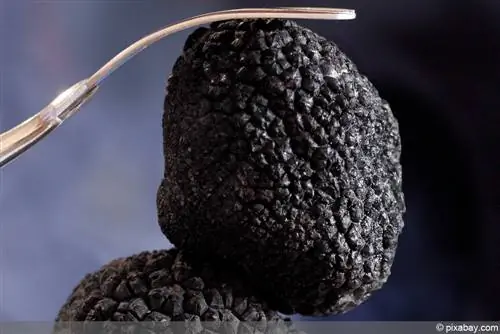- Author admin [email protected].
- Public 2023-12-17 03:39.
- Last modified 2025-01-24 12:45.
If you want to grow pineapples on your own, you can do this using seeds, leafy tufts or kindles. Anyone who eats the fruit often already has the basis for it in their hands. The tuft of leaves, the upper part of the pineapple with leaves, is ideal for this. With the right approach and a little patience, this tuft of leaves can be transformed into a finished plant.
Growing with tufts of leaves
The pineapple plant has the botanical name Ananas comosus and is very easy to grow yourself. However, since the exotic plant comes from tropical regions, it cannot cope with the temperatures at local latitudes. However, it can be grown on the windowsill and in the winter garden. This requires, among other things, the leaves, which are usually thrown away when the pineapple is eaten. This tuft of leaves sits on top of the fruit and can develop again into a fruit-bearing plant. This type of cultivation is relatively easy and promises good success in most cases. So that the stalk does not start to rot, it must be prepared accordingly. A certain drying time is required for this, otherwise cultivation is often not successful. It may take some time before the first roots develop, so patience is required.
- Use fresh and medium ripe pineapple
- Flesh should be nice and yellow, but not mushy
- Cut out the leaves with a sharp knife
- Carefully remove the entire pulp at the bottom end
- Also cut off the lowest leaves
- Now air dry the stalk for approx. 2-3 days
- Then place in a glass with a few centimeters of water to root
- Wait for a root length of a few millimeters
- Then plant the stalk in a pot with a suitable substrate
- Put the transparent film over the pot
- Alternatively, a translucent plastic bag is also possible
- Attach to the pot with a rubber band
- Place in a warm and bright location
- Water regularly, never let the soil dry out completely
- Do not keep too moist to prevent moldy substrate
- Remove the foil or bag briefly in between to ventilate it
- If the stem sprouts in the middle, the cultivation is successful
Cultivation with Kindel
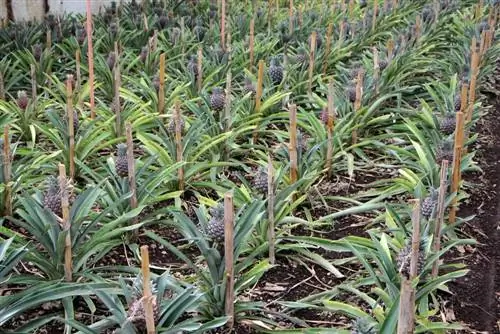
If you are already cultivating a pineapple plant yourself or with friends and family, then it is worth taking a closer look at it if you want to propagate it. In some cases, small offshoots or shoots, the so-called kindles, form directly at the base of the mother plant. These are just as suitable for cultivation as the leaf tuft. However, the child must be large enough for a new plant to develop from it. To support growth, generating a microclimate is also a good idea. In this way, the offshoot develops strong roots relatively quickly and develops into a full-fledged pineapple plant, which will then produce a fruit.
- Children should be about 20-30 cm tall
- Carefully separate offshoots
- Then plant in substrate with peat
- Afterwards water well
- Put foil or translucent plastic bag over the pot
- Place in a warm and bright place
- Air the pot occasionally to prevent mold
Tip:
Growing a pineapple with the help of Kindel can also be done hydroponically. Carefully separate the child from the mother plant and insert hydroponic pots with coarse expanded clay that are at least 12 cm high.
Propagation by sowing
Propagation using seeds is also possible, but this is much longer and more difficult to carry out. In addition, this form of cultivation does not produce pure plants. The period until the first fruit forms is also much longer. The seeds required for this are located underneath the fruit peel of the pineapple plant. However, these seeds are not found on all fruits that can be bought commercially. Seeds from very large and extremely ripe fruits ripen particularly well. For this reason, they germinate better and faster.
- Seeds are reddish-yellow to dark brown
- Located approx. 5-15 mm below the shell
- Wash thoroughly before sowing
- Remnants of the pulp can hinder the germination process
- Then place seeds in a glass of water for about a day
- Then spread on moist potting soil and press lightly
- Cover the whole thing with transparent foil
- Place in a warm and bright place
- The ideal temperature is between 20-30° C
- Air every now and then to prevent mold formation
- Germination takes a few days to several months
- The germination process usually takes about two months
- Pineapple seeds have a germination rate of around 50 percent
Growing conditions
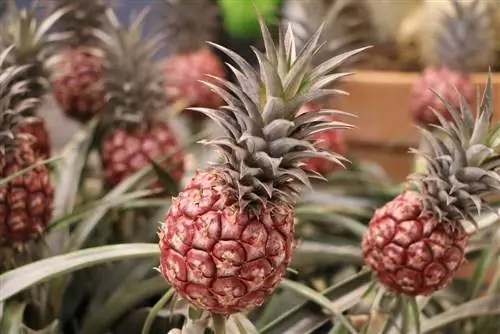
If the pineapple's offspring is to grow and thrive well, then it needs ideal growing conditions. Due to its tropical origins, the pineapple plant cannot cope with the significantly cooler temperatures in this country. For successful cultivation, the Ananas comosus needs relatively high temperatures. The warmer it is, the better the cultivation works. For this reason, neither the mother plant nor its offshoots should be kept outside; they belong in closed rooms with a controlled, warm indoor climate. In addition, the plant needs high humidity, which can only be achieved in living rooms with aids. A simple and very efficient way to increase the humidity is to cover the offspring.
- Plant is sensitive to cold and drought
- The ideal room temperature is from 25° C
- Prefers high humidity of around 60%
- Keep the substrate slightly moist at all times, water regularly
- In the early stages, do not place in full sun locations
- Avoid immediate proximity to heaters
- Place humidifier around the plant
- Alternatively, cover already potted pineapple with transparent foil
- Tendency to form mold, ensure good ventilation
- Remove the foil cover for a short time to ventilate
growing soil
In general, pineapples do not place particularly high demands on the planting substrate. However, the potting soil should have special properties so that the roots make more effort when searching for nutrients. A layer of compost in the pot provides a further incentive for the development of roots.
- Use lean potting soil to promote root growth
- Use a loose, permeable and slightly acidic plant substrate
- Clayey and sandy soil is suitable
- Perfect pH value is 5
- You can make a mixture of leaf mold and peat yourself
- Alternatively mix peat and quartz sand
- Thin layer of compost on the bottom of the pot also has a stimulating effect
- Finely sieved and ripe garden compost is optimal
- Fill this very thinly between the drainage and potting soil
Tip:
Mineral and lime-free soil based on compost can also be used as a peat substitute.

